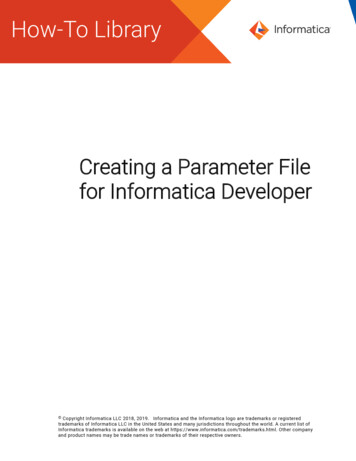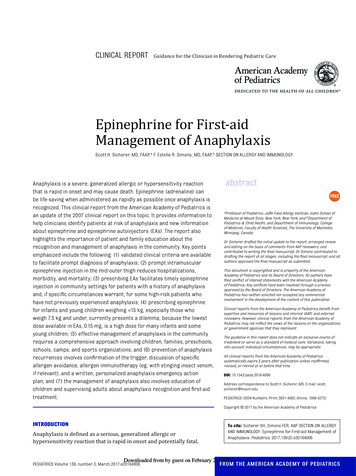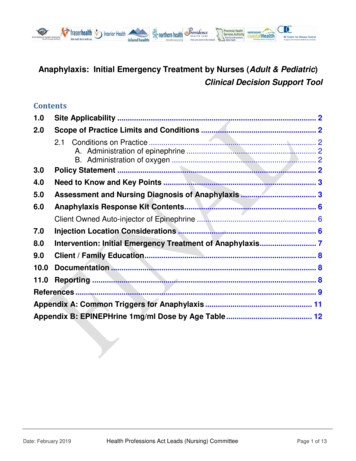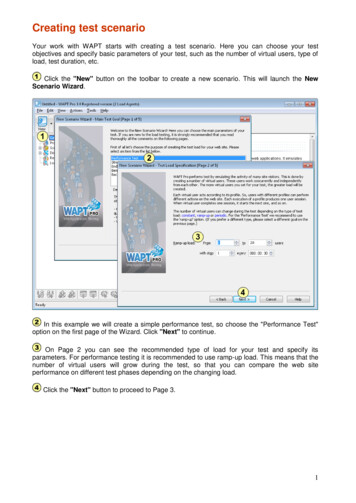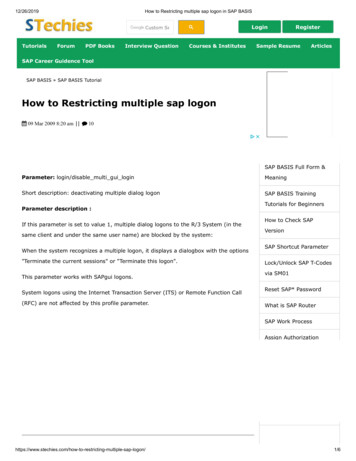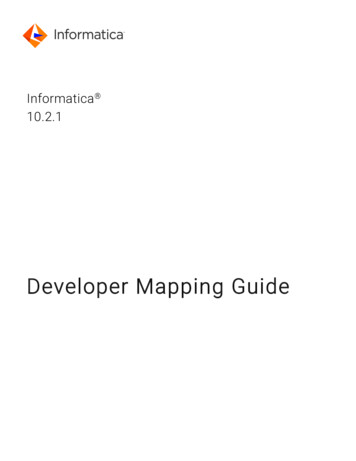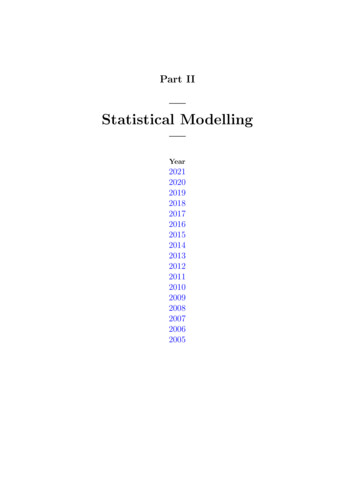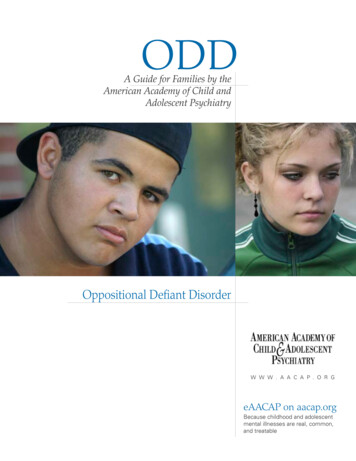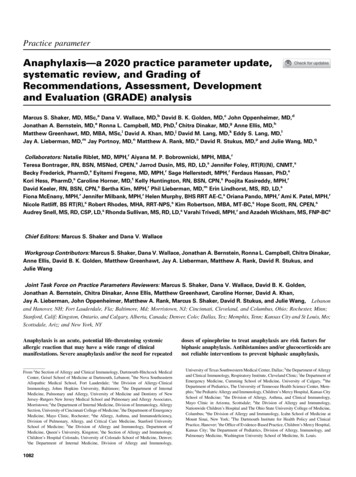
Transcription
Practice parameterAnaphylaxis—a 2020 practice parameter update,systematic review, and Grading ofRecommendations, Assessment, Developmentand Evaluation (GRADE) analysisMarcus S. Shaker, MD, MSc,a Dana V. Wallace, MD,b David B. K. Golden, MD,c John Oppenheimer, MD,dJonathan A. Bernstein, MD,e Ronna L. Campbell, MD, PhD,f Chitra Dinakar, MD,g Anne Ellis, MD,hMatthew Greenhawt, MD, MBA, MSc,i David A. Khan, MD,j David M. Lang, MD,k Eddy S. Lang, MD,lJay A. Lieberman, MD,m Jay Portnoy, MD,n Matthew A. Rank, MD,o David R. Stukus, MD,p and Julie Wang, MD,qCollaborators: Natalie Riblet, MD, MPH,r Aiyana M. P. Bobrownicki, MPH, MBA,rTeresa Bontrager, RN, BSN, MSNed, CPEN,s Jarrod Dusin, MS, RD, LD,s Jennifer Foley, RT(R)(N), CNMT,sBecky Frederick, PharmD,s Eyitemi Fregene, MD, MPH,r Sage Hellerstedt, MPH,r Ferdaus Hassan, PhD,sKori Hess, PharmD,s Caroline Horner, MD,t Kelly Huntington, RN, BSN, CPN,s Poojita Kasireddy, MPH,rDavid Keeler, RN, BSN, CPN,s Bertha Kim, MPH,r Phil Lieberman, MD,m Erin Lindhorst, MS, RD, LD,sFiona McEnany, MPH,r Jennifer Milbank, MPH,r Helen Murphy, BHS RRT AE-C,s Oriana Pando, MPH,r Ami K. Patel, MPH,rNicole Ratliff, BS RT(R),s Robert Rhodes, MHA, RRT-NPS,s Kim Robertson, MBA, MT-BC,s Hope Scott, RN, CPEN,sAudrey Snell, MS, RD, CSP, LD,s Rhonda Sullivan, MS, RD, LD,s Varahi Trivedi, MPH,r and Azadeh Wickham, MS, FNP-BCsChief Editors: Marcus S. Shaker and Dana V. WallaceWorkgroup Contributors: Marcus S. Shaker, Dana V. Wallace, Jonathan A. Bernstein, Ronna L. Campbell, Chitra Dinakar,Anne Ellis, David B. K. Golden, Matthew Greenhawt, Jay A. Lieberman, Matthew A. Rank, David R. Stukus, andJulie WangJoint Task Force on Practice Parameters Reviewers: Marcus S. Shaker, Dana V. Wallace, David B. K. Golden,Jonathan A. Bernstein, Chitra Dinakar, Anne Ellis, Matthew Greenhawt, Caroline Horner, David A. Khan,Jay A. Lieberman, John Oppenheimer, Matthew A. Rank, Marcus S. Shaker, David R. Stukus, and Julie Wang, Lebanonand Hanover, NH; Fort Lauderdale, Fla; Baltimore, Md; Morristown, NJ; Cincinnati, Cleveland, and Columbus, Ohio; Rochester, Minn;Stanford, Calif; Kingston, Ontario, and Calgary, Alberta, Canada; Denver, Colo; Dallas, Tex; Memphis, Tenn; Kansas City and St Louis, Mo;Scottsdale, Ariz; and New York, NYAnaphylaxis is an acute, potential life-threatening systemicallergic reaction that may have a wide range of clinicalmanifestations. Severe anaphylaxis and/or the need for repeateddoses of epinephrine to treat anaphylaxis are risk factors forbiphasic anaphylaxis. Antihistamines and/or glucocorticoids arenot reliable interventions to prevent biphasic anaphylaxis,From athe Section of Allergy and Clinical Immunology, Dartmouth-Hitchcock MedicalCenter, Geisel School of Medicine at Dartmouth, Lebanon; bthe Nova SoutheasternAllopathic Medical School, Fort Lauderdale; cthe Division of Allergy-ClinicalImmunology, Johns Hopkins University, Baltimore; dthe Department of InternalMedicine, Pulmonary and Allergy, University of Medicine and Dentistry of NewJersey–Rutgers New Jersey Medical School and Pulmonary and Allergy Associates,Morristown; ethe Department of Internal Medicine, Division of Immunology, AllergySection, University of Cincinnati College of Medicine; fthe Department of EmergencyMedicine, Mayo Clinic, Rochester; gthe Allergy, Asthma, and Immunodeficiency,Division of Pulmonary, Allergy, and Critical Care Medicine, Stanford UniversitySchool of Medicine; hthe Division of Allergy and Immunology, Department ofMedicine, Queen’s University, Kingston; ithe Section of Allergy and Immunology,Children’s Hospital Colorado, University of Colorado School of Medicine, Denver;jthe Department of Internal Medicine, Division of Allergy and Immunology,University of Texas Southwestern Medical Center, Dallas; kthe Department of Allergyand Clinical Immunology, Respiratory Institute, Cleveland Clinic; lthe Department ofEmergency Medicine, Cumming School of Medicine, University of Calgary, mtheDepartment of Pediatrics, The University of Tennessee Health Science Center, Memphis; nthe Pediatric Allergy and Immunology, Children’s Mercy Hospital, Kansas CitySchool of Medicine; othe Division of Allergy, Asthma, and Clinical Immunology,Mayo Clinic in Arizona, Scottsdale; pthe Division of Allergy and Immunology,Nationwide Children’s Hospital and The Ohio State University College of Medicine,Columbus; qthe Division of Allergy and Immunology, Icahn School of Medicine atMount Sinai, New York; rThe Dartmouth Institute for Health Policy and ClinicalPractice, Hanover; sthe Office of Evidence-Based Practice, Children’s Mercy Hospital,Kansas City; tthe Department of Pediatrics, Division of Allergy, Immunology, andPulmonary Medicine, Washington University School of Medicine, St. Louis.1082
J ALLERGY CLIN IMMUNOLVOLUME 145, NUMBER 4SHAKER ET AL 1083although evidence supports a role for antihistamine and/orglucocorticoid premedication in specific chemotherapyprotocols and rush aeroallergen immunotherapy. Evidence islacking to support the role of antihistamines and/orglucocorticoid routine premedication in patients receiving lowor iso-osmolar contrast material to prevent recurrentradiocontrast media anaphylaxis. Epinephrine is the first-linepharmacotherapy for uniphasic and/or biphasic anaphylaxis.After diagnosis and treatment of anaphylaxis, all patientsshould be kept under observation until symptoms have fullyresolved. All patients with anaphylaxis should receive educationon anaphylaxis and risk of recurrence, trigger avoidance,Disclosure of potential conflict of interest: The JTFPP members and work groupmembers’ conflict of interest disclosure forms can be found at www.allergyparameters.org. Jonathan Bernstein has received financial support from Sanofi, Regeneron, AstraZeneca, Merck, Optinose, Takeda, CSL Behring, Biocryst, Pharming, the National Institutes of Health, Taylor Francis, INEOS; is Editor in Chief of the Journal of Asthma,INEOS Medical Immunosurveillance Director, Vice Chair and Lectureship Chair ofthe American Academy of Allergy, Asthma & Immunology (AAAAI) Foundation,Chairman of Allergists for Israel, American College of Asthma, Allergy, and Immunology (ACAAI) Asthma Chair, Scientific Chair, and Young Investigator Award Chair;and serves of the Board of Directors and Scientific Committee of Interasma. RonnaCampbell has served as a peer reviewer for EB Medicine and an author for UpToDate.Chitra Dinakar has received financial support from Propeller Health, ACAAI (stipendfor Editorial Board of AllergyWatch), the American Association of Allergists of IndianOrigin; serves on the Board of Directors of the AAAAI and on the Medical AdvisoryBoard of Food Equity Initiative; is Assistant Editor of AllergyWatch. Anne Ellis hasreceived financial support from ALK-Abello, AstraZeneca, Green Cross, Merck, Novartis, Nuvo, Pediapharm, Pfizer, Kaleo, Novartis, Sanofi, Regeneron; serves on theBoard of Directors of the Canadian Allergy Society of Allergy and Clinical Immunology. David Golden has received financial support from Aquestive, Sandoz, ALKAbello, Sandoz, Genentech, Stallergenes-Greer, and UpToDate. Matthew Greenhawthas received financial support from Aquestive, Merck, Allergenis, Allergy Therapeutics, Sanofi Genzyme, Genentech, Aravax, Prota, Before Brands, the Institute for Clinical and Economic Review, ACAAI, DBV, Intrommune; is supported by the Agency ofHealthcare Research and Quality; has served on the advisory board of InternationalFood Protein-Induced Enterocolitis Syndrome Association, the Asthma and AllergyFoundation of America, and the National Peanut Board; and is Associate Editor ofthe Annals of Allergy, Asthma, and Immunology. Caroline Horner has served as committee chair for the AAAAI Asthma Diagnosis and Treatment Interest Section, InterestSection Coordinating Committee, and In-Training Exam Coordinating Committee.David Khan has received financial support from UpToDate and Aimmune; serves onthe Board of Directors of the AAAAI, ACAAI Chair of Literature Review, Co-Chairof Conjoint Board Review, Texas Allergy, Asthma, and Immunology Society Chairof Meetings Committee; and is Associate Editor of the Journal of Allergy and ClinicalImmunology In Practice. Eddy Lang received an honorarium from the Joint Task Forceon Practice Parameters for Grading of Recommendations, Assessment, Developmentand Evaluation methods support. Jay Lieberman has received financial support fromthe ACAAI, Aquestive, Aimmune, DBV, Biotest Pharma, and Regeneron; is AssociateEditor of the Annals of Allergy, Asthma, and Immunology, Vice Chair for the ACAAIFood Allergy Committee, and Medical Director for Food Allergy Alliance of the MidSouth. John Oppenheimer has received financial support from DBV, Teva Pharmaceutical Industries, GlaxoSmithKline adjudication/data safety monitoring board,AstraZeneca, Novartis, and Sanofi; is Associate Editor of the Annals of Allergy,Asthma, and Immunology and AllergyWatch, an American Board of Internal MedicineCouncil Member and American Board of Allergy and Immunology Liaison to theAmerican Board of Internal Medicine, UpToDate Reviewer, American College ofClinical Pharmacy Cough Guideline Committee Member, and WebMD Editor. JayPortnoy has received financial support from Thermo Fisher Scientific, Kaleo, TevaPharmaceutical Industries, Novartis, Hycor, and Boehringer-Ingelheim. MatthewRank has received financial support from the ACAAI, National Institutes of Health,and Levin Family Foundation; has served as Chair of the AAAAI Health outcomes,Education, Delivery, and Quality Interest Section; and is Research Director of thePhoenix Children’s Hospital Breathmobile. Marcus Shaker has received financial support from the Eastern Allergy Conference and has a family member who is Chief Executive Officer of Altrix Medical. David Stukus has received financial support fromAimmune, Before Brands, Abbott Nutrition, the American Academy of Pediatrics,ACAAI; has served as Committee Chair for the AAAAI and ACAAI. Dana Wallacehas received financial support from Mylan, Kaleo, Optinose, ALK-Abello, Bryan,and Sanofi; is Education Council Chair and Rhinitis/Sinusitis/Ocular Committee Chairfor the ACAAI; is Website Content Editor and ESP/WATS Committee Chair for theWorld Allergy Organization. Julie Wang has received financial support from ALKAbello, Regeneron, DBV, Aimmune; is an UpToDate author; serves on the ExecutiveCommittee of the American Academy of Pediatrics Section on Allergy and Immunology; and serves as Vice Chair of the AAAAI Anaphylaxis, Dermatitis, Drug AllergyInterest Section. David Lang declares that he has no relevant conflicts of interest.Reprints: Joint Task Force on Practice Parameters Liaison: Peris Flagg (American Academy of Allergy, Asthma, and Immunology, 555 E. Wells Street, Suite 1100,Milwaukee, WI 53202. E-mail: pflagg@aaaai.org); JTFPP.allergy@gmail.com.Previously published practice parameters of the Joint Task Force on Practice Parametersfor Allergy & Immunology are also available at org, and http://www.ACAAI.org.The Joint Task Force on Practice Parameters (JTFPP) is committed to ensuring that thepractice parameters are based on the best scientific evidence at the time of publication,and that such evidence is free of commercial bias to the greatest extent possible. TheJTFPP recognizes that experts in a field are likely to have interests that could come intoconflict with the development of a completely unbiased and objective practiceparameter. To take advantage of their expertise, a process has been developed toacknowledge potential conflicts of interest (COI) and attempt to prevent them frominfluencing the final document in a negative way. To preserve the greatest transparencyregarding potential COI, all members of the JTFPP and the practice parameters workgroups will complete a standard potential COI disclosure form prior to thedevelopment of each document, which will be available for external review by thesponsoring organization and any other interested individual. In addition, beforeconfirming the selection of the work group chairperson and members, the JTFPP willdiscuss and resolve all relevant potential COI associated with this selection. Finally, allmembers of parameter work groups will be provided a written statement regarding theimportance of ensuring that the parameter development process is free of commercialbias. During the review process there are additional measures to avoid bias. At theworkgroup level, all the sections are reviewed by all work group members to ensurethat content is appropriate and without apparent bias. If a section is deemed to haveapparent bias, it will be appropriately revised without the section author’s involvement,in an attempt to remove potential bias. In addition, the entire document is thenreviewed by the JTFPP, and any apparent bias is acknowledged and removed at thatlevel. For each and every recommendation, a vote is required by the work group andJTFPP, and any member with any perceived COI is recused from that vote (and soexplained in the document). Any dissenting votes that cannot be resolved are describedand explained in the document. In a final stage of review, the practice parameter is sentto invited expert reviewers for review, selected by the American Academy of Allergy,Asthma & Immunology (AAAAI) and the American College of Allergy, Asthma, andImmunology (ACAAI). The document is also posted on the AAAAI and ACAAIwebsites for general membership and the public-at-large to review and offer comment.All reviewers must provide statements of potential COI. Although the JTFPP has thefinal responsibility for the content of the documents submitted for publication, eachreviewer’s comments will be discussed and reviewers will receive written responses tocomments when appropriate.Disclaimer: The AAAAI and the ACAAI have jointly accepted responsibility for establishing ‘‘Anaphylaxis—a 2019 practice parameter update, systematic review andGrading of Recommendations, Assessment, Development and Evaluation (GRADE)analysis.’’ This is a complete and comprehensive document and is current at thetime of publication. The medical environment is rapidly changing and not all recommendations will be appropriate or applicable to all patients and may change over time.Because this document incorporated the efforts of many participants, no single individual, including members serving on JTFPP, are authorized to provide an official AAAAIor ACAAI interpretation of these practice parameters. Any request for information orinterpretation of this practice parameter by the AAAAI or ACAAI should be directed tothe executive offices of the AAAAI and the ACAAI. These parameters are not designedfor use by the pharmaceutical industry in drug development or promotion.Contributors: The Joint Task Force has made a concerted effort to acknowledge all contributors to this parameter. If any contributors have been excluded inadvertently, theTask Force will ensure that appropriate recognition of such contributions is made subsequently.Received for publication October 2, 2019; revised December 21, 2019; accepted for publication January 2, 2020.Available online January 28, 2020.Corresponding author: Marcus S. Shaker, MD, MSc, FAAAAI, FACAAI, FAAP, Sectionof Allergy and Clinical Immunology, Dartmouth-Hitchcock Medical Center, OneMedical Center Drive, Lebanon, NH 03756-0001. E-mail: Marcus.shaker@dartmouth.edu.The CrossMark symbol notifies online readers when updates have been made to thearticle such as errata or minor corrections0091-6749/ 36.00Ó 2020 American Academy of Allergy, Asthma & 17
1084 SHAKER ET ALself-injectable epinephrine education, referral to an allergist,and be educated about thresholds for further care. (J AllergyClin Immunol 2020;145:1082-123.)Key words: Anaphylaxis, GRADE, epinephrine, risk factors,biphasic, severity, glucocorticoids, antihistamines, pretreatmentradiocontrast media, chemotherapy, mAb, infliximab, allergenimmunotherapy, systematic meta-analysis, evidence to recommendations, guideline, practice parameterThe Joint Task Force on Practice Parameters would like todedicate this guideline to Chitra Dinakar for her ongoingcontributions and dedication to the field of allergy andimmunology.EXECUTIVE SUMMARYAnaphylaxis is an acute, life-threatening systemic allergicreaction that may have a wide range of clinical manifestations.1The clinical criteria proposed in 2006 by National Institute ofAllergy and Infectious Diseases (NIAID) continue to provide ahelpful framework in approaching patients with acute allergicsymptoms, because diagnosis and management of anaphylaxismust occur rapidly and confirmatory testing for anaphylaxis haspoor sensitivity.2 While NIAID anaphylaxis diagnostic criteriahave a sensitivity of 95% with a specificity of 71% in anemergency department (ED) setting,3 fulfilling diagnostic criteriais not a prerequisite for epinephrine administration in a patientexperiencing an acute allergic reaction.The lifetime prevalence of anaphylaxis has been estimated at1.6% to 5.1%.1,4 Risk factors for severe anaphylaxis includecardiovascular disease, asthma, older age, and additionalcoexisting, comorbid conditions.5-9 Medications and stinginginsects are the leading triggers in adults, with foods and stinginginsects the most frequently implicated triggers in children and adolescents.1,10-12 Food allergy impacts 8% to 11% of children andadults in the United States,13-15 while adverse drug reactions(ADRs) affect up to 10% of the population (and 20% ofhospitalized patients), with hypersensitivity reactions (HSRs) accounting for 10% of all ADRs.16 Although medical complexityincreases for patients with prior HSRs to radiocontrast media(RCM), fortunately the prevalence of RCM ADRs has decreasedin recent decades.17 Systemic reactions to Hymenoptera venomoccur in 0.5% to 3.3% of the US population, with most fatalitiesoccurring in patients who have no prior history of systemicallergic reaction to Hymenoptera.16IgE binding and cross-linking of the high affinity IgE receptor(FcεRI) on the surface of mast cells and basophils is an importantmechanism in many cases of anaphylaxis.18 Some patients withanaphylaxis have low or undetectable circulating allergenspecific IgE.19 Anaphylaxis involves additional cell types thatmay include neutrophils, monocytes, macrophages, and plateletsand signaling through mediators that include complement components, cysteinyl leukotrienes (LTs), platelet activating factor, IL6, IL-10, and TNF-receptor 1.20,21Epinephrine administered intramuscularly (in a dose of0.01 mg/kg of a 1:1000 [1 mg/mL] solution to a maximum of0.5 mg in adults and 0.3 mg in children) into the anterolateralthigh is the first-line treatment for anaphylaxis.22 Epinephrine isthe cornerstone of anaphylaxis management but continues to beJ ALLERGY CLIN IMMUNOLAPRIL 2020Abbreviations usedAAAAI: American Academy of Allergy, Asthma & ImmunologyACAAI: American College of Allergy, Asthma, andImmunologyADR: Adverse drug reactionC3a (4a, 5a): Complement 3a (4a, 5a)DHR: Drug hypersensitivity reactionED: Emergency departmentEMS: Emergency medical servicesFAAN: Food Allergy and Anaphylaxis NetworkFIA: Food-induced anaphylaxisGRADE: Grading of Recommendations, Assessment, Development and EvaluationH1 (2, 3, 4): Histamine 1 (2, 3, 4)HSR: Hypersensitivity reactionHVA: Hymenoptera venom allergyI2: Inconsistency of studies’ resultsIQR: Interquartile rangeJTFPP: Joint Task Force on Practice ParametersLL: Large localLT: LeukotrieneNIAID: National Institute of Allergy and Infectious DiseasesNNT: Number needed to treatNPV: Negative predictive valueOR: Odds ratioPAF: Platelet-activating factorPEER: Patient expected event ratePRISMA: Preferred Reporting Items for Systematic Reviews andMeta-AnalysesRCM: Radiocontrast mediaRIT: Rush immunotherapyRR: Relative riskunderutilized.23-25 As a nonselective adrenergic agonist,epinephrine works rapidly to increase peripheral vascularresistance through vasoconstriction, to increase cardiac output,to reverse bronchoconstriction and mucosal edema, and tostabilize mast cells and basophils.26,27 Despite underuse ofrapidly acting epinephrine as first-line treatment, fatalanaphylaxis is a rare outcome, with population prevalence ratesbetween 0.47 and 0.69 per million persons (0.25%-0.33% ofanaphylaxis hospitalizations or ED visits).9,28-31 Antihistamineagents are considered second-line treatment for anaphylaxis,given their slow onset of action and inability to stabilize orprevent mast cell degranulation or to target additional mediatorsof anaphylaxis.32 Unlike epinephrine, antihistamines will noteffectively treat cardiovascular and respiratory symptoms suchas hypotension or bronchospasm. Although glucocorticoids arefrequently used as an adjunctive therapy for anaphylaxis,evidence is lacking to support clinical benefit, and they shouldnot be administered in place of epinephrine in the treatment ofacute anaphylaxis.33,34Biphasic anaphylaxis is recurrent anaphylaxis occurring 1 to 72hours after resolution of an initial anaphylactic episode, though anoutside limit of 78 hours has also been suggested.35,36 Estimatesof biphasic anaphylaxis vary from 1% to 20% of patients;however, the ability of antihistamines and glucocorticoids toaffect this outcome is unclear.37-44 Despite a lack of clearevidence supporting the role of antihistamines andglucocorticoids in anaphylaxis, these agents continue to beroutinely used in anaphylaxis management. To evaluate the rolefor these second-line, supplemental therapies, the Joint Task
SHAKER ET AL 1085J ALLERGY CLIN IMMUNOLVOLUME 145, NUMBER 4Box 1. Key questions assessed by this systematic review on anaphylaxisTopic area 1. Identification and mitigation of risk factors for biphasic anaphylaxisQuestion 1. What risk factors should clinicians take into consideration in determining the likelihood of biphasic anaphylaxis?Topic area 2. Evaluation of the use of supplemental glucocorticoids and/or antihistamine premedication for the prevention ofanaphylaxisQuestion 2. Should antihistamines and/or glucocorticoids be used to prevent biphasic anaphylaxis?Question 3. Should antihistamine and/or glucocorticoid premedication be used to prevent index hypersensitivity/infusion reactions to chemotherapy?Question 4. Should antihistamine and/or glucocorticoid premedication be used to prevent recurrent HSRs to RCM?Question 5. Should antihistamine and/or glucocorticoid premedication be used to prevent HSRs to allergen immunotherapy orother agents?Force on Practice Parameters (JTFPP) undertook a systematicreview and Grading of Recommendations, Assessment,Development and Evaluation (GRADE) analysis of antihistamines and glucocorticoids in anaphylaxis. Specifically, the JTFPPsought to better inform the practice of anaphylaxis prevention in 2broad topic areas through (1) identification and mitigation of riskfactors for biphasic anaphylaxis and (2) evaluation of the use ofsupplemental glucocorticoid and/or antihistamine premedication(see Box 1). Although the goal of the JTFPP was to rigorouslyevaluate the literature to form evidence-based recommendations,there are limits to the available evidence in human anaphylaxisdue to ethical considerations and the absence of double-blindstudies in a potentially fatal, acute condition. This GRADEanalysis incorporated the balance of relative benefits and harmsof treatments under consideration, the certainty of the evidence,and the impact of patient preferences and values. Box 2 providesa summary of key clinical advice.Question 1. What risk factors should clinicians takeinto consideration in determining the likelihood ofbiphasic anaphylaxis?Recommendation 1. We suggest that a clinician incorporateseverity of anaphylaxis presentation and/or the administration of 1 dose of epinephrine for the treatment of initialanaphylaxis as a guide to determining a patient’s risk fordeveloping biphasic anaphylaxis. Conditional recommendation. Certainty rating of evidence: very low.Even though the ability to accurately predict which patientswith resolved initial anaphylaxis will experience biphasicanaphylaxis is imperfect, an understanding of risk factors allowsa more tailored approach to patient management. Risk factors alsoprovide useful parameters to incorporate into decision makingregarding duration of observation following initial resolution ofanaphylaxis.The JTFPP findings suggest biphasic anaphylaxis is associatedwith a more severe initial presentation of anaphylaxis (odds ratio[OR], 2.11; 95% CI, 1.23-3.61) or repeated epinephrine doses (ie, 1 dose of epinephrine) required with the initial presentation(OR, 4.82; 95% CI, 2.70-8.58). Additional risk factors includewide pulse pressure (OR, 2.11; 95% CI, 1.32-3.37), unknownanaphylaxis trigger (OR, 1.63; 95% CI, 1.14-2.33), cutaneoussigns and symptoms (OR, 2.54; 95% CI, 1.25-5.15), and drugtrigger in children (OR, 2.35; 95% CI, 1.16-4.76). While presenceof dyspnea on presentation was associated with a decreased riskfor anaphylaxis, overall confidence in this estimate was low (OR,0.6; 95% CI, 0.38-0.96). Prompt and adequate treatment ofanaphylaxis appears central to reducing biphasic anaphylaxisrisk, in the opinion of the JTFPP. While the possibility of biphasicanaphylaxis should be emphasized in this higher risk group, it isimportant to educate all patients regarding the chance of abiphasic reaction as well as avoiding known triggers,identification of symptoms of anaphylaxis, the use ofauto-injector epinephrine for the treatment of anaphylaxis, andtimely follow-up with an allergist.Recommendation 2. We suggest extended clinical observation in a setting capable of managing anaphylaxis (to detect abiphasic reaction) for patients with resolved severe anaphylaxisand/or those who need 1 dose of epinephrine. Conditionalrecommendation. Certainty rating of evidence: very low.While wide pulse pressures may be considered a marker forsevere anaphylaxis, the clinician may also consider extendedobservation for patients with an unknown anaphylaxis trigger andchildren with a drug trigger. Incorporating cutaneous signs andsymptoms into a clinical decision for extended observation maybe limited by the common occurrence of cutaneous signs andsymptoms in patients presenting with anaphylaxis. The estimatednumber needed to monitor with extended observation to be able todetect 1 episode of biphasic anaphylaxis before discharge wouldbe 41 (range, 18-195) for patients with a more severe initialpresentation of anaphylaxis and 13 (range, 7-27) for patients withmultiple epinephrine doses. The implication for the clinician,based on this systematic review and meta-analysis, is that thepatient presenting with severe anaphylaxis and/or requiring moreaggressive treatment (eg, 1 dose of epinephrine) should beconsidered for longer observation time for a potential biphasicreaction following complete resolution of signs and symptoms. Atpresent, evidence is lacking to clearly define the optimal durationof observation (eg, number of hours) that would prove to be costeffective for patients with initial resolution of severe anaphylaxisand/or those requiring multiple doses of epinephrine. However,for patients without severe risk features, discharge after a 1-hourasymptomatic observation may be reasonable. If the clinicalimpression is that a patient has a higher risk of biphasicreaction (ie, 17% or greater) or risk factors for anaphylaxisfatality (eg, cardiovascular comorbidity, lack of access toepinephrine, lack of access to emergency medical services(EMS), poor self-management skills), then extended observationof up to 6 hours or longer (including hospital admission) may beappropriate. Regardless of severity, after diagnosis and treatmentof anaphylaxis, all patients should be kept under observation untilsigns and symptoms have fully resolved.
1086 SHAKER ET ALJ ALLERGY CLIN IMMUNOLAPRIL 2020Box 2. Suggested key clinical advicedddddddddSevere anaphylaxis and/or the need for 1 dose of epinephrine to treat anaphylaxis are risk factors for biphasic anaphylaxis.Additional risk factors include wide pulse pressure, unknown anaphylaxis trigger, cutaneous signs and symptoms, and drugtrigger in children.Extended observation is suggested for patients with resolved severe anaphylaxis and/or those with need for 1 dose ofepinephrine.Antihistamines and/or glucocorticoids are not reliable interventions to prevent biphasic anaphylaxis but may be consideredas secondary treatment.Evidence supports a role for antihistamine and/or glucocorticoid premedication in specific chemotherapy protocols and rushaeroallergen immunotherapy.Evidence is lacking to support the routine use of antihistamines and/or glucocorticoid premedication in patients receivinglow- or iso-osmolar contrast material to prevent recurrent RCM anaphylaxis.Administer epinephrine as the first-line pharmacotherapy for uniphasic and/or biphasic anaphylaxis.Do not delay the administration of epinephrine for anaphylaxis.After diagnosis and treatment of anaphylaxis, all patients should be kept under observation until symptoms have fullyresolved.All patients with anaphylaxis should receive education about anaphylaxis, risk of recurrence, trigger avoidance, selfinjectable epinephrine, and thresholds for further care, and they should be referred to an allergist for follow-up evaluation.Question 2. Should antihistamines orglucocorticoids be used to prevent biphasicanaphylaxis?Recommendation. We suggest against administeringglucocorticoids or antihistamines as an intervention toprevent biphasic anaphylaxis. Conditional recommendation.Certainty rating of evidence: very low.Although we suggest against the use of antihistamines and/orglucocorticoids as an intervention to prevent biphasicanaphylaxis, these may be considered for the secondary treatmentof anaphylaxis.45 In particular, antihistamines may treat urticariaand
Board of Food Equity Initiative; is Assistant Editor of AllergyWatch. Anne Ellis has received financial support from ALK-Abello, AstraZeneca, Green Cross, Merck, No-vartis, Nuvo, Pediapharm, Pfizer, Kaleo, Novartis, Sanofi, Regeneron; serves on the Board of Directors of the Canadian Allergy Society of Allergy and Clinical Immu-nology.
